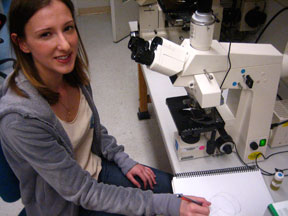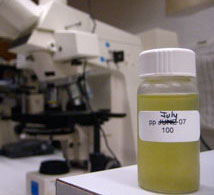 |
||||
Science Illustration |
||||
 |
|
Corlis Schneider graduated from UC Santa Cruz with a degree in Marine Biology. "After taking Marine Plankton I discovered how complex, fascinating, and beautiful plankton can really be, and that one way to express this (for myself, and to others) was through drawing the individual organisms. In the process I learned a lot about the plankton I was viewing." |
||
Corlis has used phytoplankton samples from the weekly collection at the Santa Cruz Wharf for her drawings, viewing the samples with an Axioskop microscope. She also works from photographs and diagnostic literature. |
 |
|||
 |
Corlis working on a drawing of a diatom. Below, she describes the scientific illustration process: | |||
"Describing different organisms in nature through drawing can be a very rewarding experience. It is different from taking a picture, because you have the ability to accentuate important features that are diagnostic of certain species. Using the microscope to observe organisms can be tricky at first. Understanding the type of microscope you are working with, and the limitations and features, is important when you are considering how to observe and draw your sample. Using preservatives means that the cells are not still swimming on your slide, making them easier to draw. Keep in mind that preservatives often change the original color, and sometimes shapes, of the organisms preserved in them. If your sample is from a net tow, it may be dense with plankton. Carefully invert the bottle, once or twice, to mix the sample evenly. (If you do not, you may end up with a mass of indistinguishable plankton on your slide.) Use a pipette and bulb to draw out a small amount of the sample. Place 1 to 2 drops on the center of your slide. Any more than that, and your cover slip will float away! Take the cover slip and stand it on the slide at the edge of the drop. Once the slip touches the drop, simply let it fall onto the sample. This will help you avoid any major bubbles that occur when the slip is dropped directly onto the slide. Put your sample on the stage and into the slide holder. You should turn the light on at a low level. Use the lowest level of the objective lenses to begin focusing on your sample. The type of microscope you use will have specific instructions on how to focus the ocular lenses, and how to use the coarse and fine focus knobs. It is important to focus your sample at a low level, otherwise it will be very difficult to focus it at higher levels. Having good focus decreases eye stress, headaches, and nausea. When you have an organism in the field of view you wish to draw, take careful note of its dimensions. It is especially helpful to have an eyepiece with grid marks on it. Sketching the organism is the best part. Single-celled organisms can be extraordinarily complex and beautiful. What you see in the microscope is guaranteed to be unique. Working from a microscope does have its disadvantages: the extra pressure from the slide and cover slip and heat from the light may cause plankton cells to burst. Make sure you work at a reasonable pace! When working with plankton you may use a fresh sample, either a whole water sample or a net tow, or a stock of preserved plankton. Sea water samples may contain live organisms that will move around on your slide. This is excellent for observing and understanding the organism you want to draw, but it can also be difficult to keep it in the field of view long enough to get a good sketch! Preserved samples should be handled in a fume hood or near a snorkel, because some preservatives can be toxic. The organisms in preserved samples will be dead." |
||||